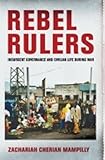Rebel Rulers : Insurgent Governance and Civilian Life during War / Zachariah Cherian Mampilly.
Material type: TextPublisher: Ithaca, NY : Cornell University Press, [2012]Copyright date: ©2015Description: 1 online resource (320 p.) : 4 halftones, 2 line drawings, 6 maps, 1 tableContent type:
TextPublisher: Ithaca, NY : Cornell University Press, [2012]Copyright date: ©2015Description: 1 online resource (320 p.) : 4 halftones, 2 line drawings, 6 maps, 1 tableContent type: - 9780801462979
- Civilians in war -- Congo (Democratic Republic)
- Civilians in war -- Sri Lanka
- Civilians in war -- Sudan
- Insurgency -- Congo (Democratic Republic)
- Insurgency -- Sri Lanka
- Insurgency -- Sudan
- Political Science & Political History
- Sociology & Social Science
- POLITICAL SCIENCE / Security (National & International)
- global resistance movements
- political insurgents, insurgent leaders, insurgent government, rebel political authority, rebels that become leaders, rebel leaders, congelese rebel readers, global conflict and cooperation
- 321 22
- DS489.84 .M356 2011
- online - DeGruyter
| Item type | Current library | Call number | URL | Status | Notes | Barcode | |
|---|---|---|---|---|---|---|---|
 eBook
eBook
|
Biblioteca "Angelicum" Pont. Univ. S.Tommaso d'Aquino Nuvola online | online - DeGruyter (Browse shelf(Opens below)) | Online access | Not for loan (Accesso limitato) | Accesso per gli utenti autorizzati / Access for authorized users | (dgr)9780801462979 |
Browsing Biblioteca "Angelicum" Pont. Univ. S.Tommaso d'Aquino shelves, Shelving location: Nuvola online Close shelf browser (Hides shelf browser)

|

|

|

|

|

|

|
||
| online - DeGruyter Urban Flow : Bike Messengers and the City / | online - DeGruyter From Iron Rice Bowl to Informalization : Markets, Workers, and the State in a Changing China / | online - DeGruyter Creating Cistercian Nuns : The Women's Religious Movement and Its Reform in Thirteenth-Century Champagne / | online - DeGruyter Rebel Rulers : Insurgent Governance and Civilian Life during War / | online - DeGruyter At Home with the Diplomats : Inside a European Foreign Ministry / | online - DeGruyter The Logic of Positive Engagement / | online - DeGruyter The Origin of Sin : An English Translation of the "Hamartigenia" / |
Frontmatter -- Contents -- List of Illustrations -- Preface -- List of Abbreviations -- 1. Introduction: Governing Rebels -- 2. Bandits, Warlords, Embryonic States, Black Spots, and Ungoverned Territories: The Unwieldy Taxonomy of Rebel-Governed Areas -- 3. Understanding Variation in Insurgent Governance Systems -- 4. The Two Faces of the Tiger: Sri Lanka’s Liberation Tigers of Tamil Eelam -- 5. Building a New Sudan: The Sudan People’s Liberation Movement/Army -- 6. Resurrecting Bula Matari: The Rassemblement Congolais pour la Démocratie-Goma -- 7. Comparative Insurgent Governance -- 8. Rules and Resistance: New Agendas for Studying Insurgency and Governance -- Appendix: Interview Methodology and List of Interviewees -- References -- Index
restricted access online access with authorization star
http://purl.org/coar/access_right/c_16ec
Rebel groups are often portrayed as predators, their leaders little more than warlords. In conflicts large and small, however, insurgents frequently take and hold territory, establishing sophisticated systems of governance that deliver extensive public services to civilians under their control. From police and courts, schools, hospitals, and taxation systems to more symbolic expressions such as official flags and anthems, some rebels are able to appropriate functions of the modern state, often to great effect in generating civilian compliance. Other insurgent organizations struggle to provide even the most basic services and suffer from the local unrest and international condemnation that result.Rebel Rulers is informed by Zachariah Cherian Mampilly's extensive fieldwork in rebel-controlled areas. Focusing on three insurgent organizations—the Liberation Tigers of Tamil Eelam (LTTE) in Sri Lanka, the Rally for Congolese Democracy (RCD) in Congo, and the Sudan People's Liberation Movement/Army (SPLM/A) in Sudan—Mampilly's comparative analysis shows that rebel leaders design governance systems in response to pressures from three main sources. They must take into consideration the needs of local civilians, who can challenge rebel rule in various ways. They must deal with internal factions that threaten their control. And they must respond to the transnational actors that operate in most contemporary conflict zones. The development of insurgent governments can benefit civilians even as they enable rebels to assert control over their newly attained and sometimes chaotic territories.
Mode of access: Internet via World Wide Web.
In English.
Description based on online resource; title from PDF title page (publisher's Web site, viewed 26. Apr 2024)


